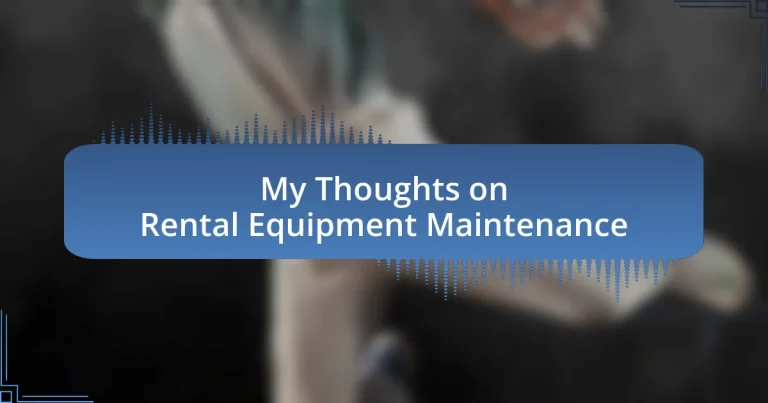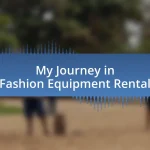Key takeaways:
- Regular maintenance and inspections are crucial for the safety, efficiency, and longevity of rental equipment.
- Keeping detailed maintenance logs helps track the service history and ensures timely upkeep, reducing potential breakdowns.
- Effective troubleshooting of common issues, such as unusual sounds or startup problems, can prevent escalation and ensure smooth operations.
- Budgeting for maintenance costs helps avoid unexpected expenses, promoting smoother and financially sound rental operations.
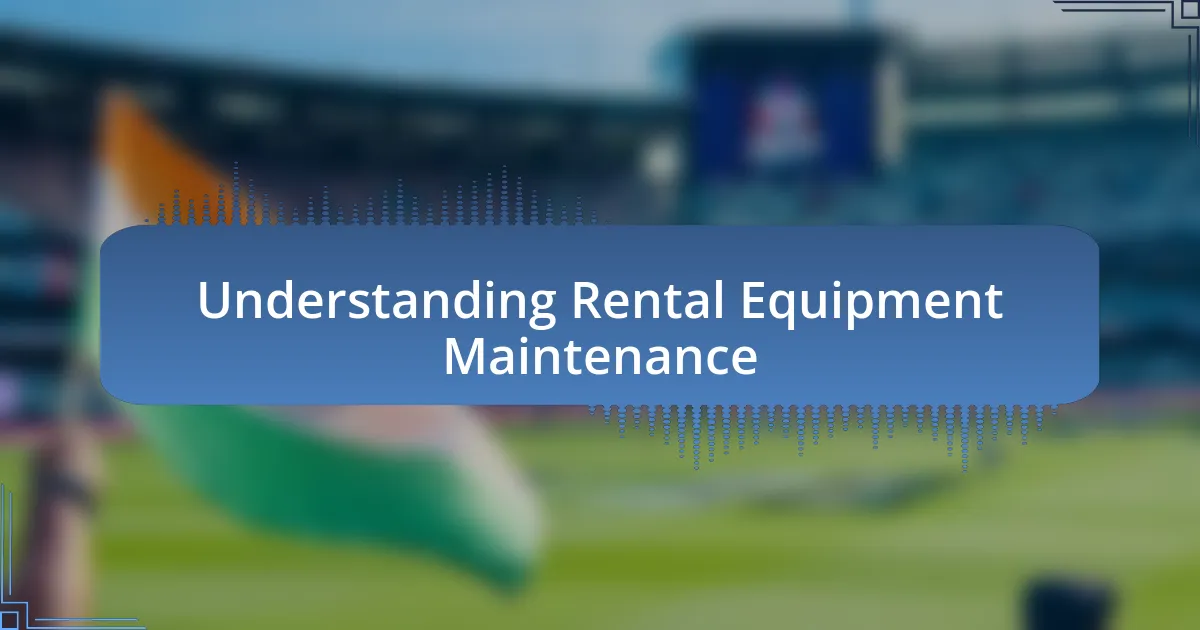
Understanding Rental Equipment Maintenance
Maintaining rental equipment is crucial for both the efficiency of the machinery and the safety of those using it. I remember a time when I neglected to properly check the oil levels in a generator before a big event. The generator failed halfway through, leaving us scrambling for a solution, which taught me the hard way that regular checks can save not just time but also a lot of stress.
When I think about equipment maintenance, I often wonder: how many of us overlook the importance of preventative care? It’s really a mindset shift. Instead of waiting for a breakdown, if we treat maintenance as part of our routine, it can dramatically extend the life of the equipment and enhance its performance. Embracing this mindset has been transformative for me—especially when I started keeping a maintenance log. Seeing the improvements in reliability was eye-opening.
Moreover, understanding the specifics of each piece of equipment is vital. For instance, I had a friend who rented a high-powered saw but didn’t read the manual first. He ended up using the wrong blade, which led to both a safety hazard and the need for repairs that weren’t covered under his rental agreement. This experience strongly reinforces the idea that knowledge, coupled with regular maintenance, empowers us to use rental equipment safely and effectively.
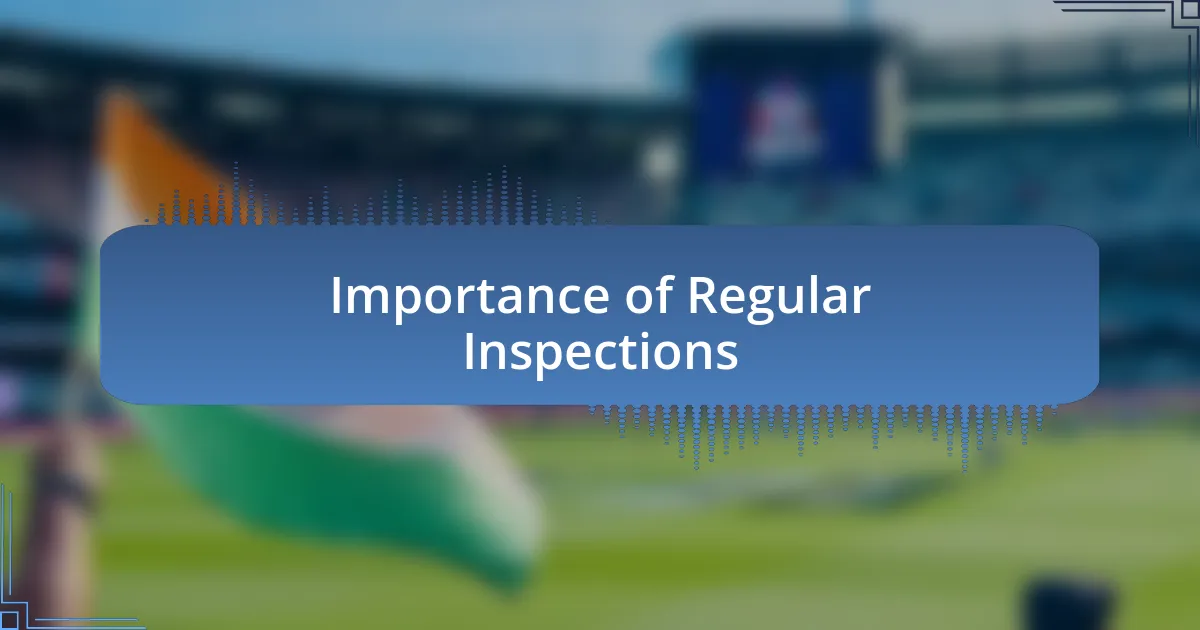
Importance of Regular Inspections
Regular inspections are fundamental in ensuring that rental equipment operates at peak performance. I’ve often found that a simple check can uncover issues before they escalate into major problems. For example, during my own experience renting a once-trusty power washer, I neglected to inspect the hoses. When I finally did, I discovered a small crack that could have led to a serious malfunction during use. Regular inspections act as a safeguard against unexpected breakdowns and operational inefficiency.
Here are key benefits of conducting regular inspections:
- Safety Assurance: Regular checks identify potential hazards, reducing the risk of accidents.
- Cost Savings: Spotting minor issues early can prevent costly repairs down the line.
- Enhanced Equipment Longevity: Consistent maintenance leads to better durability and performance.
- Improved Reliability: Knowing that equipment has been inspected builds confidence for users, minimizing stress during operations.
- Compliance with Regulations: Many industries require documentation of regular inspections for safety audits.
Every inspection is an opportunity for peace of mind and a step toward ensuring that the equipment performs as expected, which I now prioritize in every rental decision.
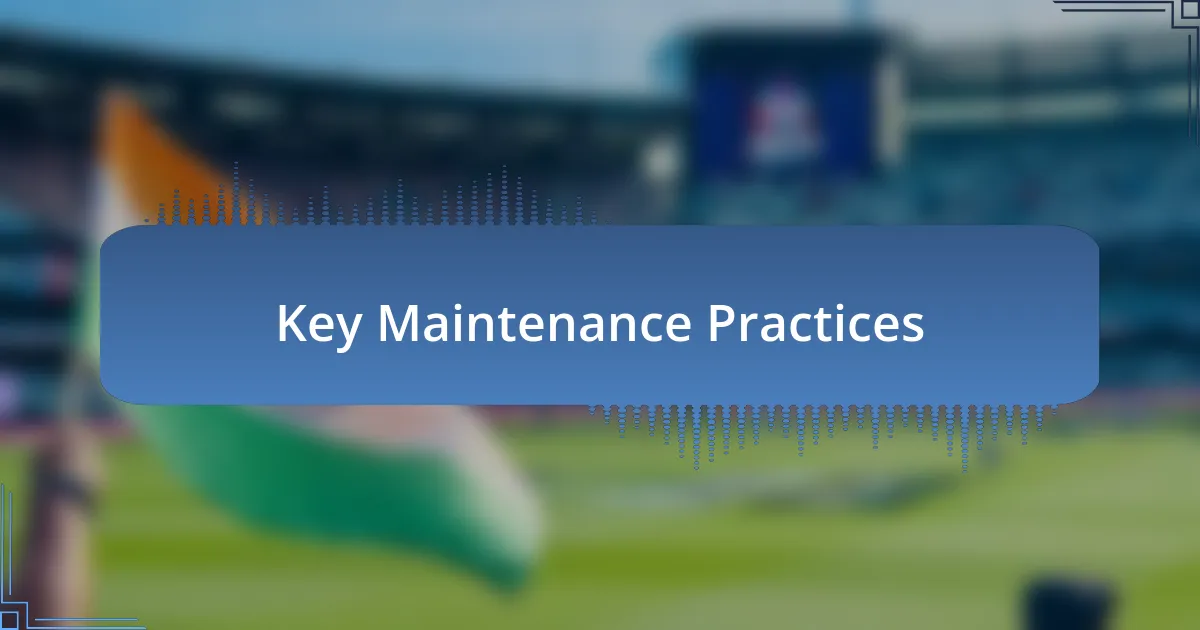
Key Maintenance Practices
Key Maintenance Practices
Proper maintenance ensures that rental equipment remains reliable and safe. One practice I never skip is cleaning equipment after each use. A recent experience with a rented generator taught me that debris and dirt can accumulate quickly, affecting performance. By simply dedicating a few minutes to clean it, I not only extended its lifespan but also ensured it was ready for the next job without a hitch.
Another essential practice I’ve learned over time is keeping detailed maintenance logs. Documenting each service can feel tedious, but trust me, it pays off. When I rented a lawnmower recently, I noticed how the previous user’s notes helped me understand its maintenance history, which assured me it was in good shape for my yard work. This practice helps track when maintenance is due and prevents overlooking critical tasks, ultimately leading to smoother operations.
Finally, routine lubrication of moving parts cannot be overstated. I remember once operating a rented chainsaw and being stunned by how much smoother it ran after applying the correct lubricant. Not only did it enhance its performance, but it also reduced wear and tear. Keeping parts lubricated ensures everything runs efficiently, ultimately saving time and reducing the risk of unexpected breakdowns.
| Maintenance Practice | Description |
|---|---|
| Cleaning | Remove debris and dirt after each use to enhance performance and longevity. |
| Maintenance Logs | Document all services and inspections to track maintenance history and needs. |
| Lubrication | Apply lubricant to moving parts to ensure smooth operation and prevent wear. |
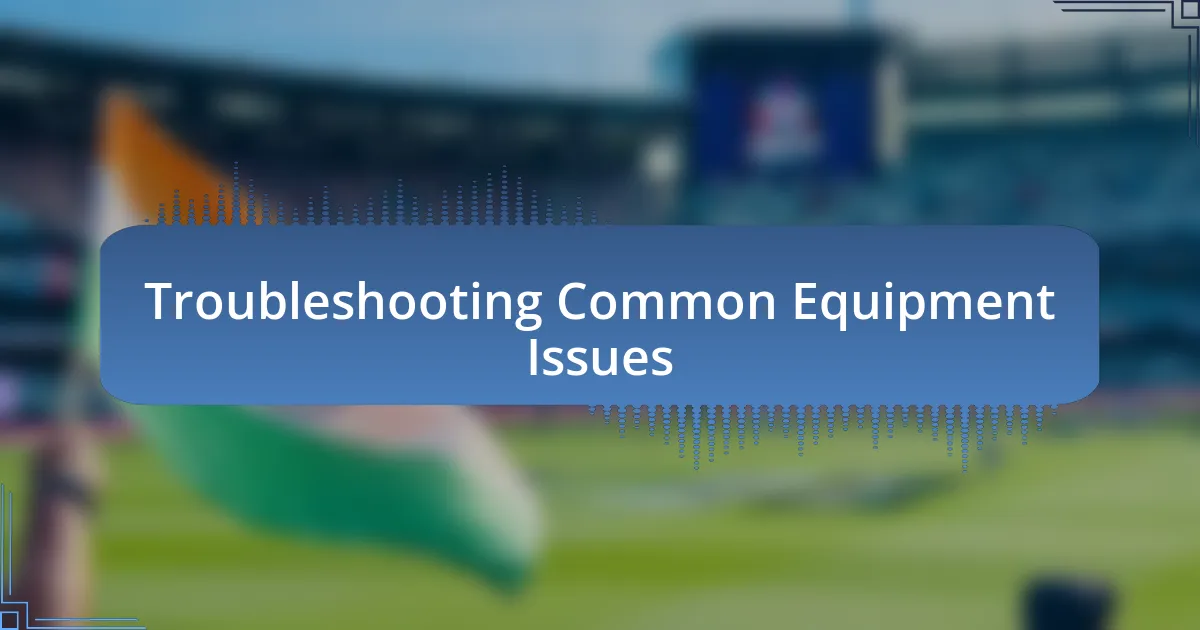
Troubleshooting Common Equipment Issues
One common issue I’ve encountered with rental equipment is mechanical noise during operation. I remember using a borrowed tiller that suddenly started making a grinding sound. It was a bit unsettling, and I knew I had to act quickly. In situations like this, it’s important to pause and inspect the equipment thoroughly. Often, a simple check for loose bolts or debris caught in the mechanisms can resolve the issue. Have you ever ignored a strange sound, only to find out it led to bigger problems later?
Another familiar problem is equipment not starting, which can be incredibly frustrating, especially when you’re pressed for time. Just last season, I faced this dilemma with a rented pressure washer. I took a moment to review the fuel levels and check the spark plug. It turned out to be a simple oversight, but it taught me the value of methodical troubleshooting. Have you considered how easy it can be to overlook the fundamentals when you’re in a rush?
Lastly, connectivity issues with power equipment can leave you scratching your head. I once struggled with a rented nail gun that just wouldn’t fire. After a few moments of panic, I discovered that the safety lock was engaged. It’s a good reminder that sometimes the simplest solutions are the hardest to see under pressure. Regular checks of switches and safety features can save time and prevent those frustrating moments when you’re in the middle of a project. How do you typically handle unexpected equipment surprises?

Effective Record Keeping Strategies
Keeping organized records has always been an essential part of effective rental equipment maintenance. My experience shows that using a simple spreadsheet can do wonders. I remember starting with just a notebook to log maintenance dates, yet switching to a digital format allowed me to track everything from usage hours to repair histories at a glance. Isn’t it easier to see patterns when all the information is in one place?
I’ve also found that including photos in my records is incredibly helpful. A few seasons back, I documented every piece of equipment with before-and-after shots after maintenance. This visual reference not only helped me remember the condition of the items but also served as a powerful reminder of my commitments to upkeep. Have you considered how visuals could enhance your record-keeping?
Moreover, establishing a routine for record updates can make a significant difference. I dedicate a few minutes after each rental return to input data and review notes. This practice ensures I don’t overlook any crucial details and keeps my records fresh and accurate. How often do you take the time to reflect on your equipment’s status? Regular maintenance is about more than just the physical tools; it’s also about maintaining peace of mind.
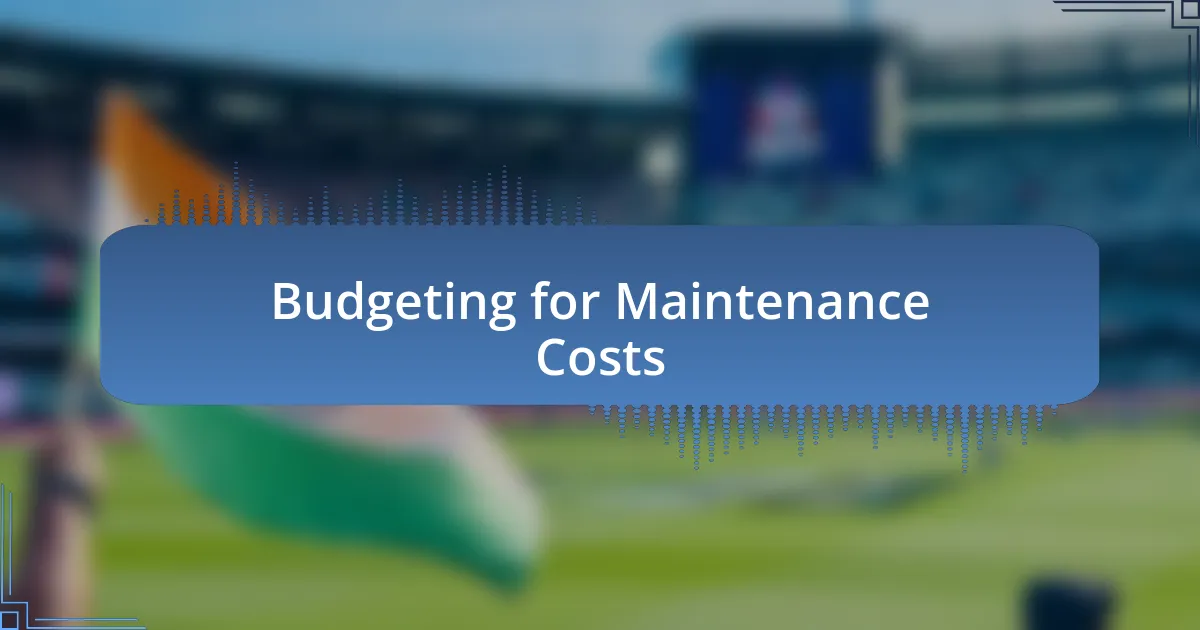
Budgeting for Maintenance Costs
Budgeting for maintenance costs is often an overlooked aspect of equipment rental that can have a significant impact on profit margins. I remember when I first started out; I was so focused on securing rentals that I failed to allocate funds for upkeep. The unexpected repair bills hit me hard, and I quickly learned that setting aside a budget for maintenance is essential to avoid financial surprises. Have you ever faced a situation where neglecting maintenance costs impacted your bottom line?
One practical approach I’ve adopted is creating a dedicated maintenance fund. Each month, I put a percentage of my rental income into this account specifically for maintenance and repairs. This method not only provides peace of mind but also ensures that I can quickly address any issues without stress. I often reflect on how much smoother my operations run now that I’m financially prepared for maintenance. Could this strategy work for you too?
I also like to analyze past maintenance expenses to inform my future budgets. By reviewing the costs associated with various pieces of equipment, I’ve gained insights into which items require more frequent servicing. This experience has helped shape a more accurate budget and allowed me to prioritize investments. How does your historical data influence your budgeting decisions?
